Investigation of Thermal Instability of Additive-Based High-Efficiency Organic Photovoltaics
Abstract
Most photovoltaics operate at high temperature under sunlight. In this work, the thermal instability of diiodooctane-based high-efficiency bulk heterojunction (BHJ) organic photovoltaics (OPVs) is studied. The BHJ layers were heated to various temperatures to investigate the changes in their physical properties using atomic force microscopy phase images. The mobilities of the carriers were characterized at various temperatures using the space-charge-limited current method, and the carrier lifetime was calculated by applying impedance spectroscopy to the simulated equivalent circuit of the OPV devices.
1. Introduction
Organic photovoltaics (OPVs) have received interest due to their simple fabrication and potential for large-area devices [1]. OPVs commonly have a bulk heterojunction (BHJ) [2–7] structure, where p-type (donor) and n-type (acceptor) materials are mixed to increase the area of the donor/acceptor interface to effectively extract electrons and holes from excitons. The efficiencies of single and tandem OPVs have reached around 9% [8] and 10.2% [9].
OPVs with a BHJ structure can be fabricated using a solution process. The morphology of the active layer determines light soaking performance. The carrier extraction from excitons to the electrodes is difficult to control. To form a BHJ layer with a favorable morphology, methods such as thermal annealing, solvent annealing, and additive addition have been applied to modify the crystallization of materials to improve the interaction and interpenetration between holes and electrons. Recently, additives such as diiodooctane (DIO) [10, 11], 1,8-octanedithiol (OT) [12], 1-chloronaphthalene (CN) [13], and nitrobenzene (NB) [14] have been introduced to change the morphology of the BHJ layer. These changes are due to the difference in volatility between the main solvent and the additive and the difference in solubility between the donor and acceptor materials and that of the main solvent and the additive. High-efficiency OPV single cells have been derived [8] using a light-harvesting layer, thieno[3,4-b]thiophene/benzodithiophene (PTB7): [6,6]-phenyl C71-butyric acid methyl ester (PC71BM), blended with 3% DIO, reaching a power conversion efficiency (PCE) of 9.214%.
Although high-performance devices have been obtained by controlling the morphology of the BHJ layer, to prevent the PCE from degrading, the arrangement of the donor and acceptor materials should be stable under working conditions. However, most photovoltaics are exposed to direct sunlight, and thus they harvest not only light but also radiant heat. In OPVs, heat determines the crystallization of the donor and acceptor materials and affects the morphology of the BHJ layer. Hence, the thermal stability of the donor and acceptor materials in the BHJ layer is very critical to the performance of OPV devices exposed to sunlight. The present study investigates the thermal stability of high-efficiency OPV devices based on poly[(4,8-bis-(2-ethylhexyloxy)-benzo[1,2-b;4,5-b′]dithiophene)-2,6-diyl-alt-(4-(2-ethylhexanoyl)-thieno[3,4-b]thiopene)-2,6-diyl] (PBDTTT-C):PC71BM BHJ blended with 3% DIO in dichlorobenzene. The effect of heat on the morphological and electrical characteristics of DIO-modified BHJ is investigated.
2. Experimental Details
PBDTTT-C:PC71BM-based OPVs were fabricated on indium tin oxide- (ITO-) coated glass substrates. The substrates were cleaned with acetone, isopropanol, and deionized water in an ultrasonic cleaner. Before poly(3,4-ethylenedioxythiophene)-poly(styrenesulfonate) (PEDOT:PSS) was coated onto ITO, the substrates were treated with UV zone for 15 min. After a ~30 nm thick layer of PEDOT:PSS was deposited, the film was annealed for 15 min at 120°C. Then, a ~90 nm thick layer of PBDTTT-C:PC71BM was spin-coated on the PEDOT:PSS. The concentration of the PBDTTT-C:PC71BM (1 : 1.5) blend solution for spin-coating was 10 mg/mL (polymer/solvent). 1,2-Dichlorobenzene (DCB) was used as the solvent. DIO was added into the solution (at 3%) to DCB prior to the spin-coating process. Calcium (Ca) and aluminum (Al) layers were deposited on PBDTTT-C:PC71BM in a thermal evaporator with thicknesses of 20 and 100 nm, respectively. The device, with a structure of ITO/PEDOT:PSS/PBDTTT-C:PC71BM/Ca/Al, had an area of 0.1 cm2.
The current density-voltage (J-V) characteristics of the OPV devices were measured using a Keithley 2400 source measure unit under AM 1.5 G illumination at 100 mW/cm2 with a Newport Thermal Oriel 91192 1000-W solar simulator. The external quantum efficiency (EQE) values of the devices were derived using a halogen-tungsten lamp, a monochromator, an optical chopper, and a lock-in amplifier. The photon flux was calibrated using a silicon photodiode.
3. Results and Discussion
3.1. J-V Characteristics
The PBDTTT-C:PC71BM films without DIO were heated to temperatures of 60 to 100°C, respectively, for 5 min on a hot plate. The J-V curves of the devices for various temperatures are shown in Figure 1(a) and the optoelectronic properties are shown in Table 1. As shown, there is little difference in performance for temperatures up to 90°C. In contrast, the device performance drops slightly at a temperature of 100°C, indicating that the interaction between PBDTTT-C and PC71BM in the PBDTTT-C:PC71BM film without DIO begins to vary at 100°C. The morphology of BHJ films without DIO should thus be quite stable below 100°C. With 3% DIO in the PBDTTT-C:PC71BM films, the more favorable morphology would be obtained leading to better performance, and the thermal stability of the BHJ films should be more important. Figure 1(b) shows the J-V curves of the OPV devices with PBDTTT-C:PC71BM film with 3% DIO heated to 60 to 100°C, respectively, for 5 min. The optoelectronic properties are listed in Table 1 with 10 devices for each condition. There is nearly no physical difference between the PBDTTT-C:PC71BM film without heating and that heated at 60°C according to the similar J-V characteristics. However, the device performance drops significantly for temperatures of 70°C and higher. The open-circuit voltage (Voc) increases slightly and the short-circuit current density (Jsc) slightly decreases with increasing temperature. The fill factor (FF) decays dramatically with temperature, dominating the degradation of the PCE. Consequently, although the J-V characteristics of the PBDTTT-C:PC71BM-based OPV device with DIO are better than those of the device without DIO, the thermal stability of the former is much worse than that of the latter.
| Voc (V) | Jsc (mA/cm2) | FF (%) | PCE (%) (max.) | PCE (%) (min./avg.) | ||
|---|---|---|---|---|---|---|
| Without DIO | Non | 0.781 | 10.86 | 54.18 | 4.6 | 4.38/4.46 |
| 60°C | 0.778 | 11.12 | 53.55 | 4.63 | 4.39/4.57 | |
| 70°C | 0.778 | 11.3 | 52.36 | 4.6 | 4.51/4.53 | |
| 80°C | 0.781 | 11.14 | 52.37 | 4.56 | 4.32/4.36 | |
| 90°C | 0.774 | 11.33 | 52.32 | 4.59 | 4.35/4.4 | |
| 100°C | 0.767 | 10.68 | 53.71 | 4.4 | 4.2/4.32 | |
| With 3% DIO | Non | 0.71 | 13.87 | 63.06 | 6.21 | 6.09/6.14 |
| 60°C | 0.719 | 13.88 | 61.16 | 6.11 | 6.03/6.07 | |
| 70°C | 0.724 | 13.66 | 52.99 | 5.24 | 4.89/5.05 | |
| 80°C | 0.726 | 13.07 | 51.94 | 4.93 | 4.83/4.9 | |
| 90°C | 0.726 | 13.04 | 50.95 | 4.83 | 4.71/4.77 | |
| 100°C | 0.725 | 12.68 | 48.24 | 4.43 | 4.13/4.26 | |
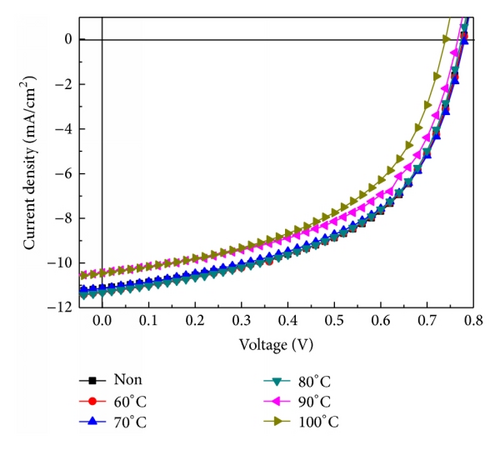
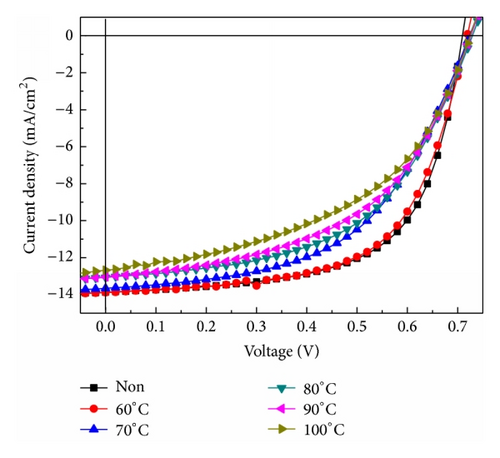
3.2. AFM Phase Images
The heating temperatures applied to the films are not high enough to break the chains of PBDTTT-C and burn PC71BM, and thus the degradation of the J-V characteristics must be attributed to the variation of the interaction between the polymer and PC71BM in the BHJ layer, which correlates to the morphology of the films. Figure 2 shows the atomic force microscopy (AFM) phase images of the PBDTTT-C:PC71BM film without thermal treatment and those heated to 70, 80, 90, and 100°C, respectively, for 5 min. As shown, the phase variation range is large (from ±5° to ±10°) for temperatures of 70 and 80°C, becoming even larger (±100°) at 90 and 100°C. Moreover, the phase separation becomes increasingly obvious with increasing temperature due to the morphological difference between PC71BM clusters and PBDTTT-C chains leading to completely different interactions between the two materials at different temperatures. The more obvious the phase separation, the worse the performance. This is especially true for the device heated to 100°C, whose phase image is extremely different from those of the others.
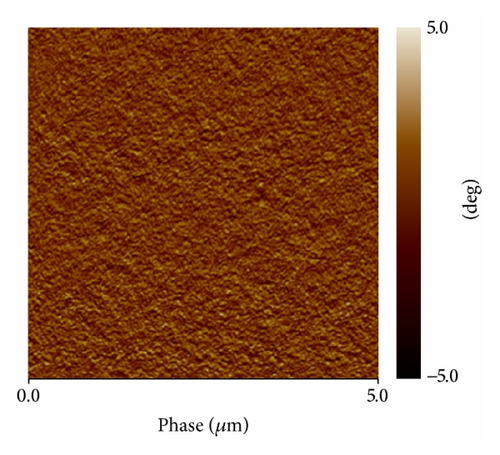
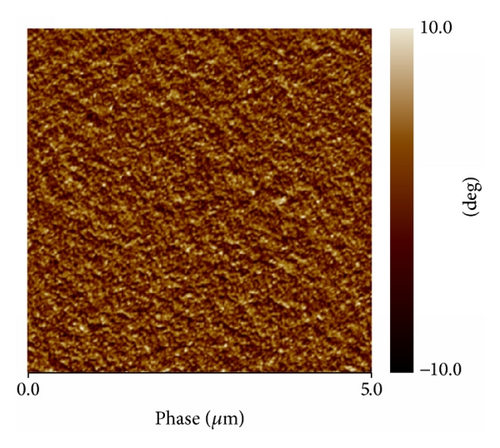

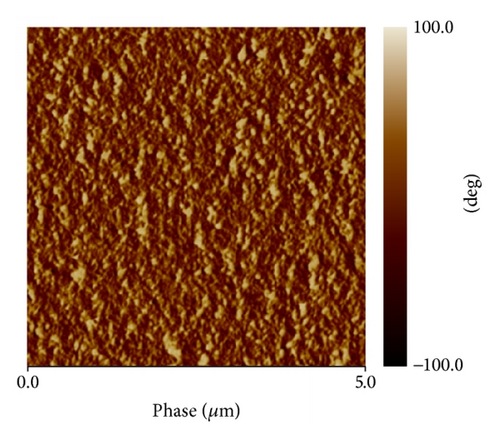

3.3. EQE and SCLC
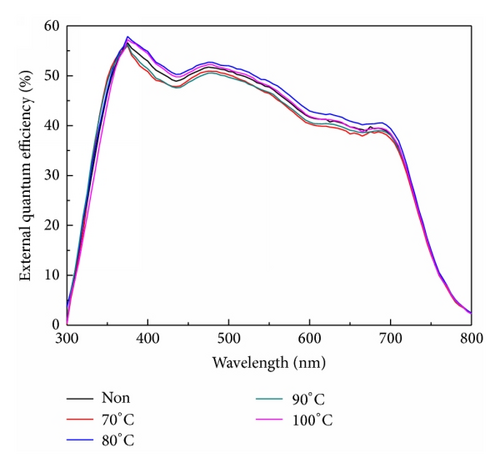
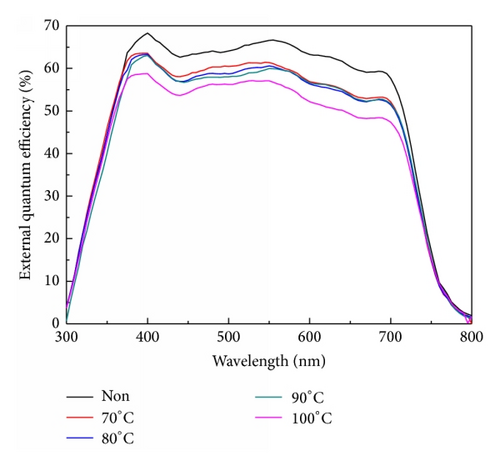
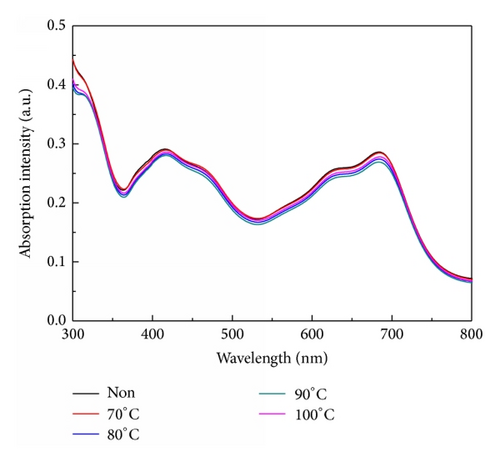
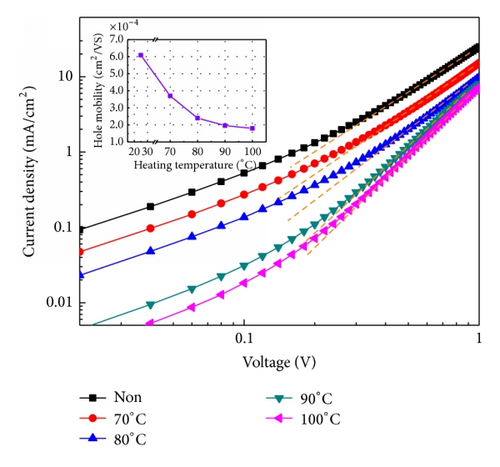
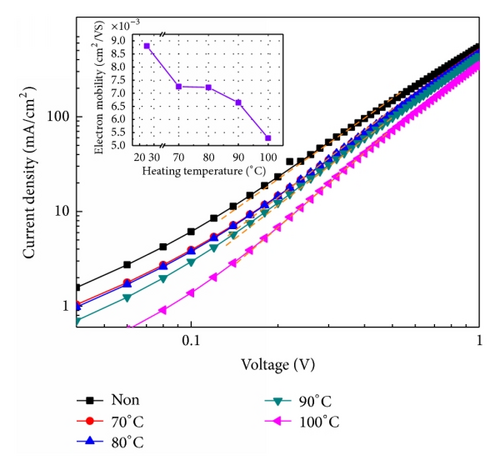
3.4. Impedance Analysis
| R1 (Ω) | C1 (F) | τavg (second) | PCE (%) | |
|---|---|---|---|---|
| Non | 540.48 | 1.7463E − 08 | 9.4384E − 06 | 6.21 |
| 70°C | 585.65 | 1.5688E − 08 | 9.1877E − 06 | 5.24 |
| 80°C | 621.86 | 1.3334E − 08 | 8.2919E − 06 | 4.93 |
| 90°C | 641.35 | 1.1874E − 08 | 7.6154E − 06 | 4.83 |
| 100°C | 692.81 | 1.0436E − 08 | 7.2302E − 06 | 4.43 |
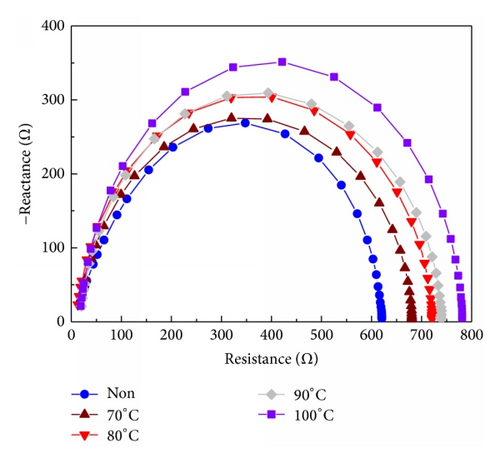
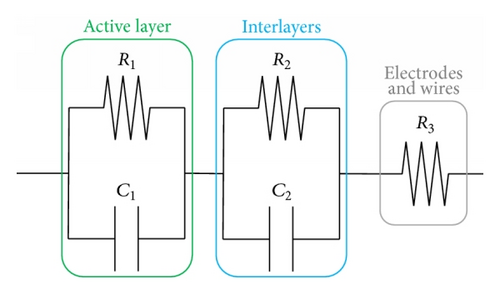
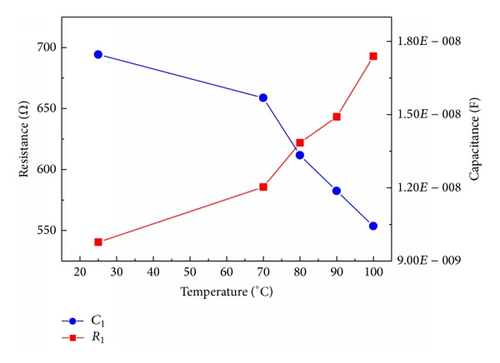
4. Conclusion
In this work, the effect of temperature on the performance of DIO-blended high-efficiency BHJ OPV devices was investigated. An unfavorable morphology of the BHJ layer was observed in AFM phase images after heating to over 70°C. The morphology obtained at high temperature not only degraded the EQE characteristics of the BHJ layer but also diminished the carrier penetration, which degraded the performance of the OPV devices. The average carrier lifetimes in the BHJ layer, derived from impedance spectra, shortened with increasing temperature, decreasing the PCE. The thermal stability of OPV devices with DIO is thus a critical issue.
Conflict of Interests
The authors declare that there is no conflict of interests regarding the publication of this paper.
Acknowledgment
This work was supported by the National Science Council of the Republic of China, Taiwan, under Grants NSC 100-2221-E-006-041-MY3 and NSC 100-2221-E-006-039-MY3.




